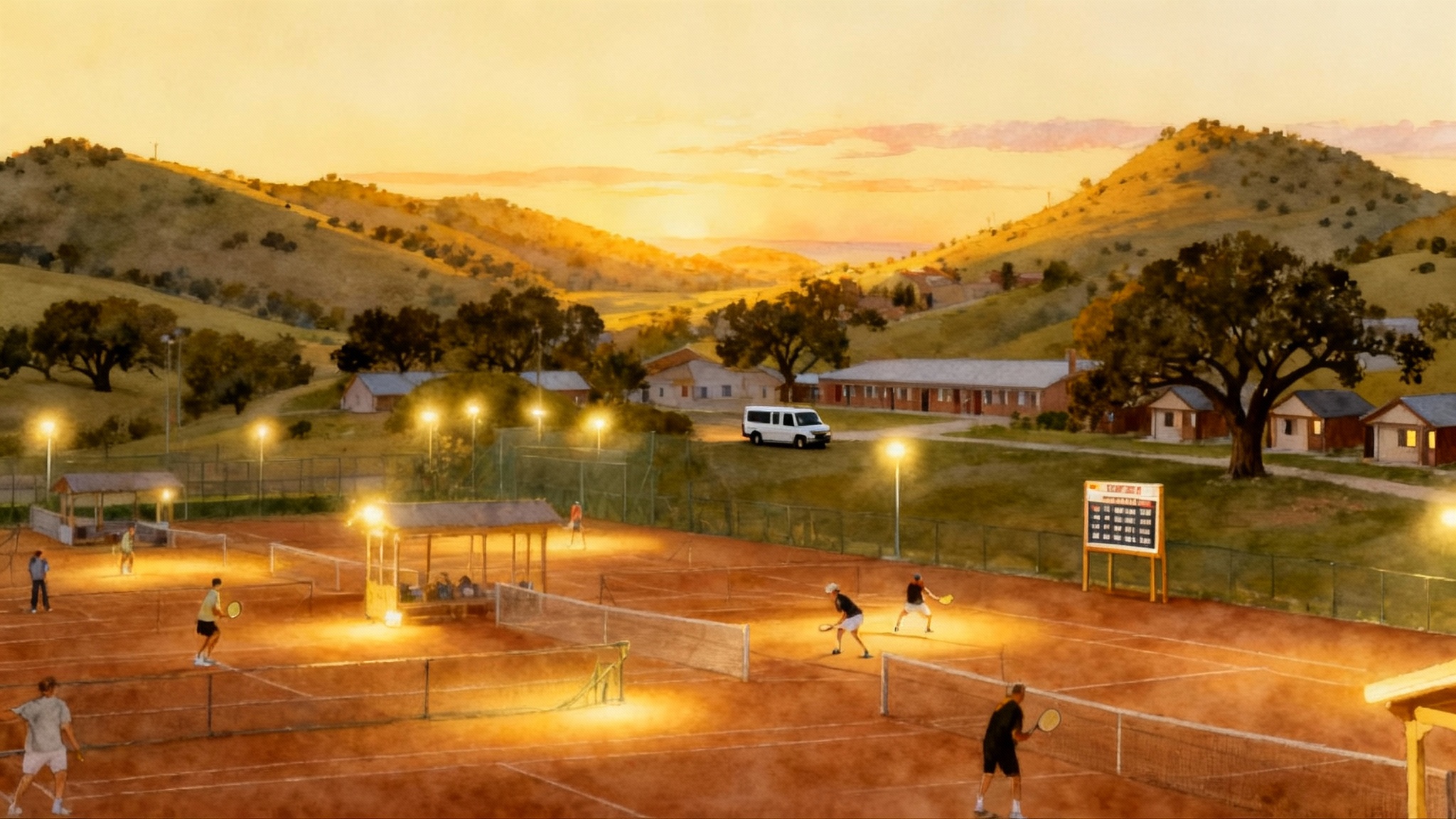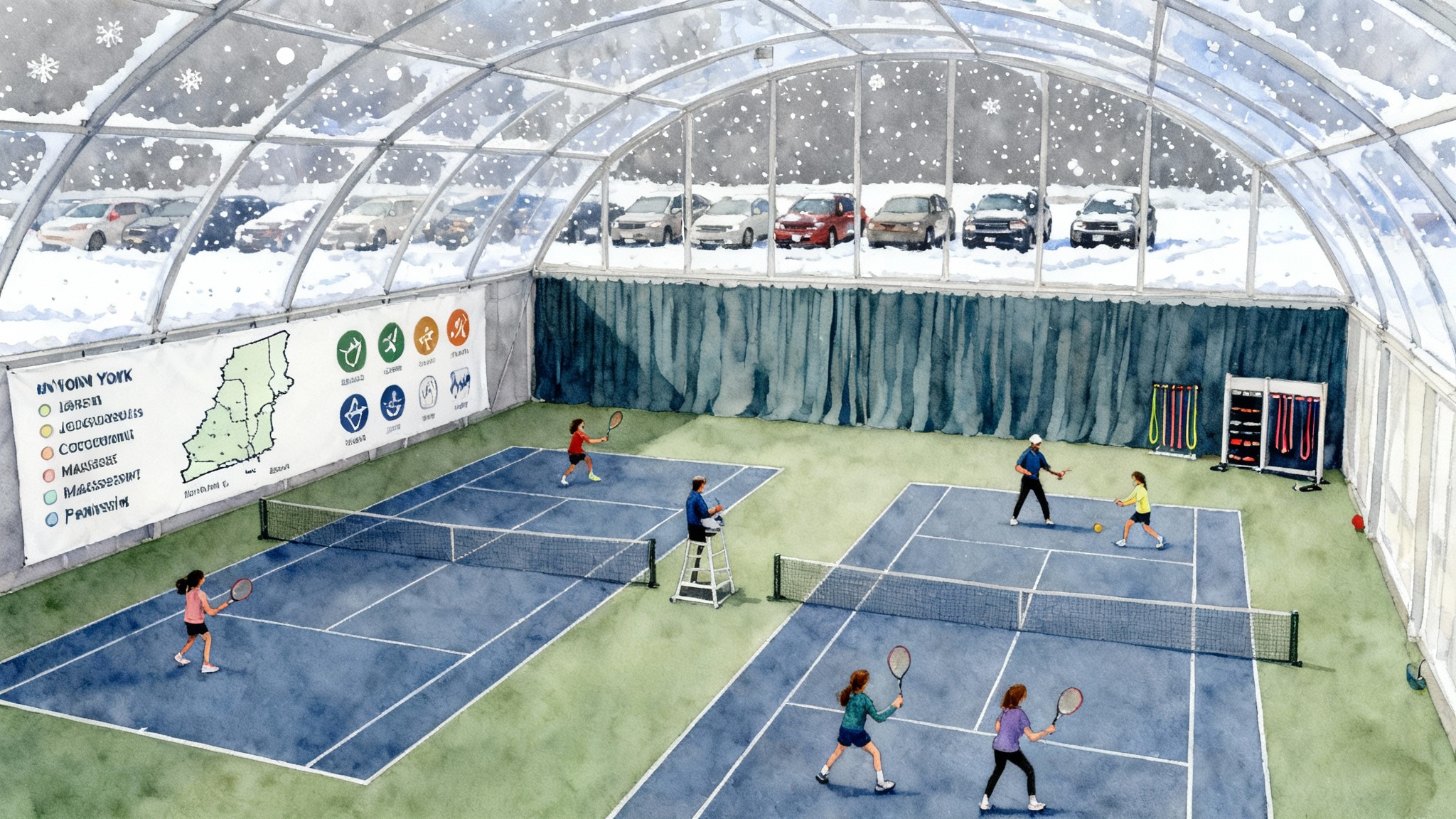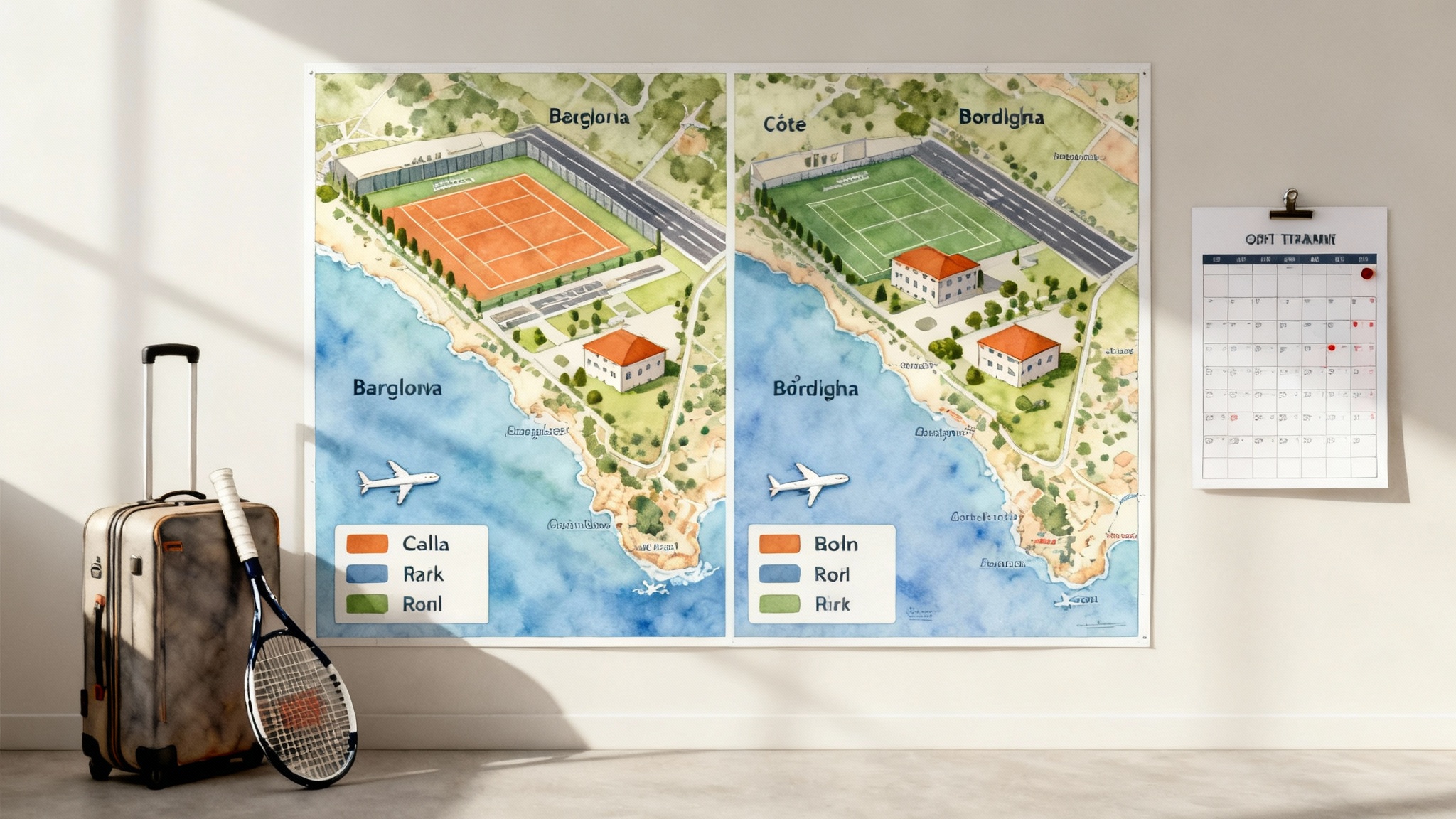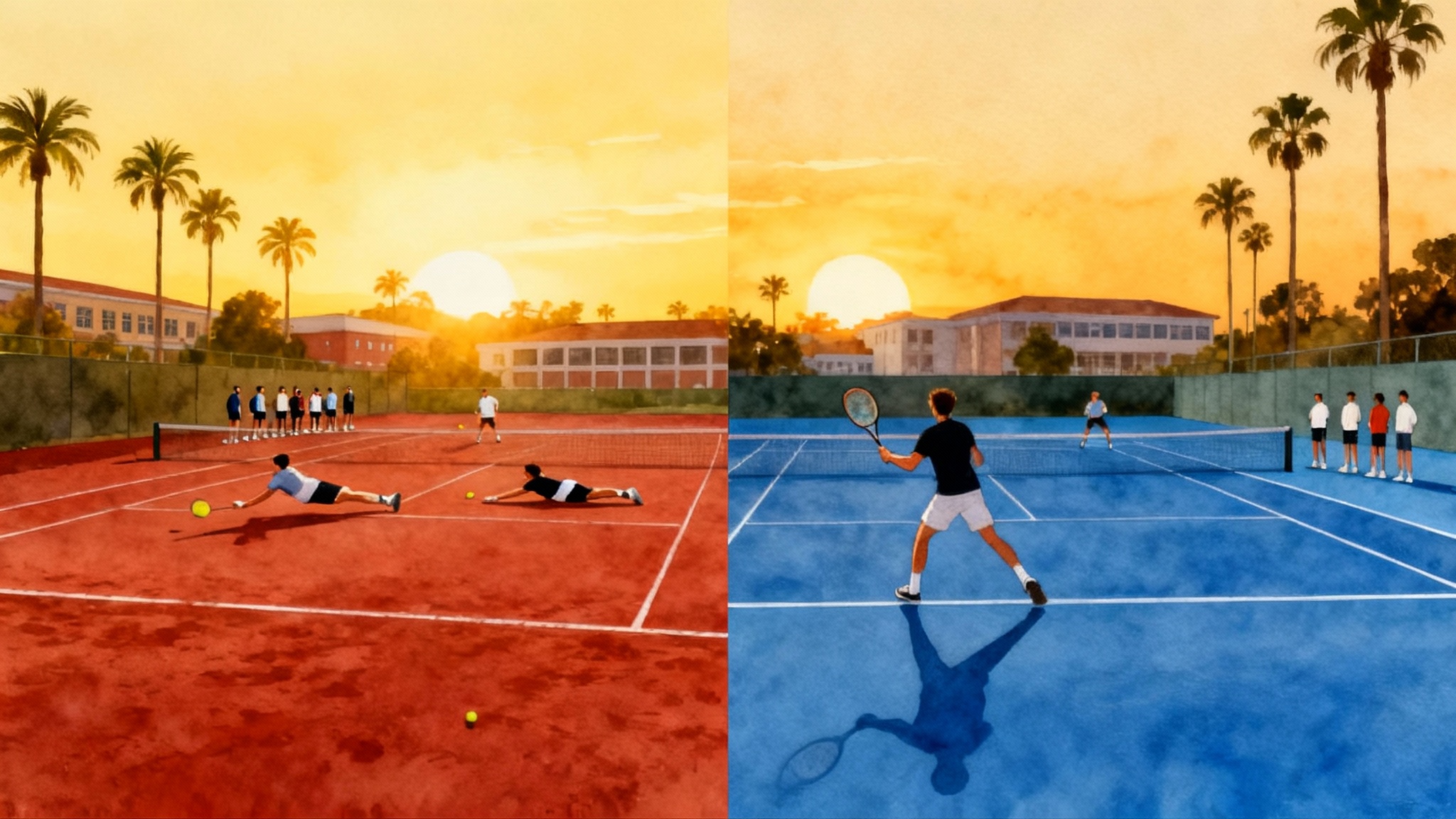Best California Tennis Academies for Adults in 2025–2026
A practical, data-backed guide to California’s best adult tennis academies and bootcamps across NorCal and SoCal. Compare weekend intensives and weeklong camps, prices, coach quality, surfaces, fitness add-ons, and how to align with NTRP or UTR goals.
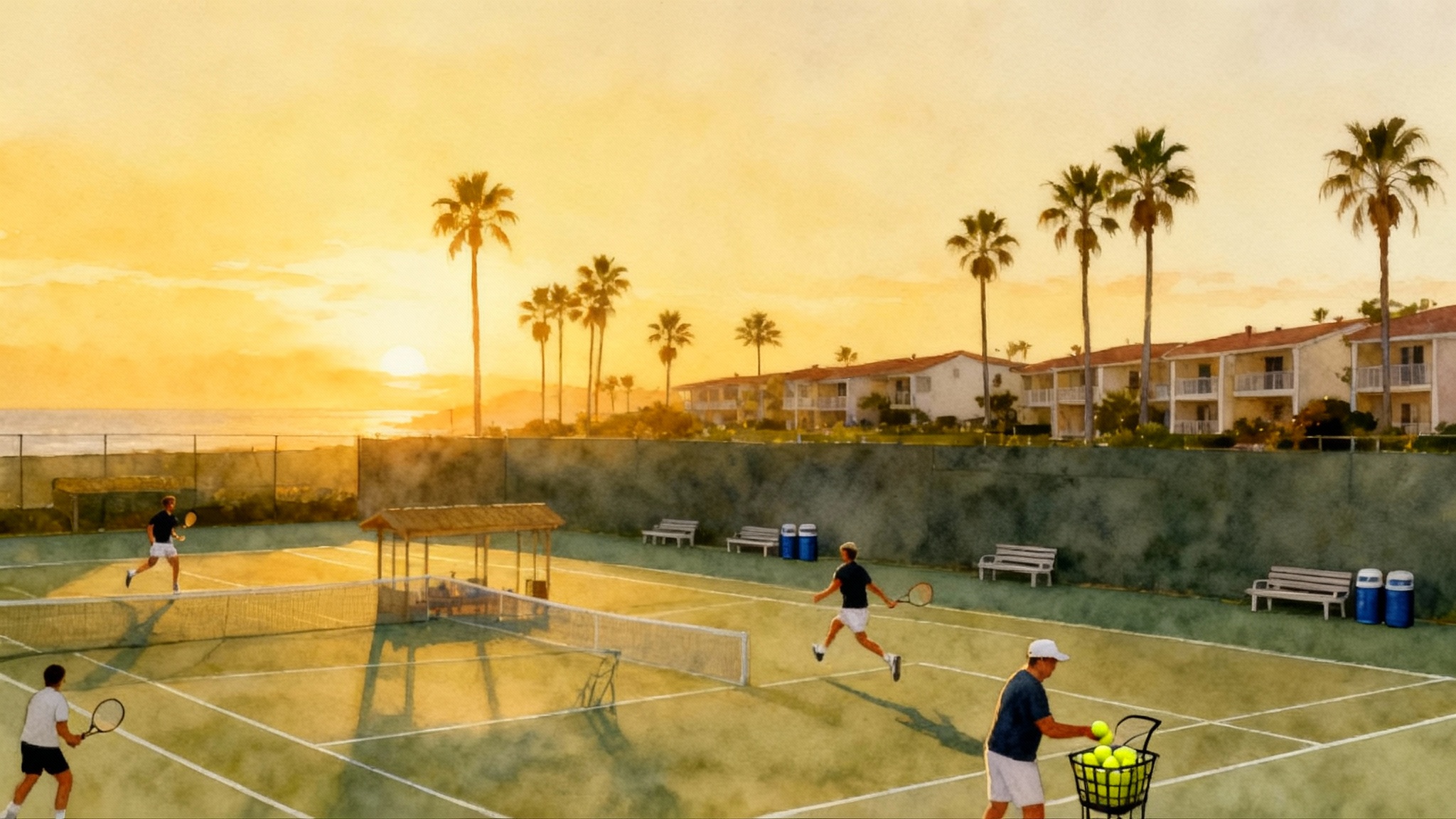
How we built this shortlist
Adult players ask two questions first: Will this program match my level, and will it move my rating. To answer both, we compared California offerings that consistently run adult‑specific camps or can structure adult blocks on request. We looked at training volume per day, the split between technical instruction and live‑ball, coach credentials, surface variety, recovery options, seasonal pricing, and how easily you can pair training with competitive play for measurable progress. When the same venue hosts multiple formats, we evaluated weekend intensives and weeklong camps separately.
The California landscape at a glance
California has three distinct adult‑training clusters that matter for planning.
- Southern California resorts and academies: Carlsbad, La Quinta, Rancho Mirage, Rancho Santa Fe, Newport Beach, and the Indian Wells corridor. These locations offer high court density, reliable weather from October to May, and many adult‑friendly live‑ball sessions.
- Northern California universities and clubs: Stanford, Santa Clara, Sonoma County, Marin, and San Francisco. These often run structured adult camps in spring and summer with strong coach pedigrees and easy access to events.
- Coastal retreats: Monterey Peninsula and Carmel Valley feature boutique programs that blend serious training with recovery and good food. Volume per day can be lower than desert intensives, but the quality of coaching and small‑group ratios offset that.
Who shines for adults in 2025 to 2026
The names below are grouped by format so you can match the experience to your goal.
- Resort‑run intensive camps in SoCal: Programs based at Carlsbad and the greater Palm Springs area specialize in high‑rep drilling, point play, and clean progressions for NTRP 3.0 to 4.5. Expect strong live‑ball culture, low staff turnover, and easy private add‑ons. Clay is limited; most volume is on medium‑pace hard courts.
- Indian Wells corridor clinics and match play: Adult blocks near Indian Wells add match sets or open play later in the day. This is a good fit if your goal is to convert practice to pressure reps on the same day.
- University‑based adult camps in NorCal: Stanford and other Bay Area campuses offer weeklong camps in summer with a heavier technical progression in the mornings and controlled point play after lunch. Staff often includes former Division One players and certified coaches.
- Boutique coastal programs in Carmel Valley and Monterey: Smaller groups, excellent ball‑feeding, and access to hiking or cold water recovery. Best for players who want two high‑quality sessions daily rather than three.
- Private academies offering adult weeks by request: Orange County and Ojai based academies will build custom adult mini‑camps if you have a group of four to eight. This path is efficient for doubles teams preparing for a league flight or a specific sectional. For example, the Weil Tennis Academy adult weeks in Ojai can customize small‑group plans.
Tip: if you do not see an adult week on the calendar, email the director. Many California sites will open a session when two courts’ worth of players commit.
Weekend intensives vs weeklong camps
The right choice depends on your rating target and your calendar.
- Weekend intensive, 2.5 to 3.5 players: Great for movement and contact reps. You will hit a lot of balls and clean up a few key stroke leaks with one focused private lesson. Translate gains to league play immediately.
- Weekend intensive, 4.0 to 4.5 players: Best for pattern and serve plus one development. The pace is high. You will benefit most if you arrive with a clear film‑backed goal such as raising first serve percentage by five points or winning more than 55 percent of second‑serve points.
- Weeklong camp, 3.0 to 4.0: Ideal if you need technical rebuild on one stroke plus doubles positioning. Spreading volume across five days lowers fatigue while you change grips or swing paths.
- Weeklong camp, 4.0 to 5.0: Choose programs that schedule daily match or set play. You will need pressure reps to consolidate new patterns.
A simple rule: choose weekend intensives to sharpen, weeklong camps to change. Sharpening aims at timing and decision speed. Changing aims at mechanics and patterns.
Price ranges and booking windows
California adult camps price by session length, staff ratio, and season. Typical ranges in 2025:
- Weekend intensive, group only: 399 to 899 dollars per person for five to ten on‑court hours.
- Weeklong group camp: 1,200 to 2,500 dollars per person for 15 to 24 on‑court hours.
- Private lesson add‑ons: 100 to 200 dollars per hour depending on the director.
- Hitting partner sessions: 40 to 80 dollars per hour.
- Fitness and recovery add‑ons: 20 to 50 dollars for guided mobility or recovery lounge access.
Booking windows: Desert programs from January through March fill first. Reserve six to twelve weeks ahead for Indian Wells and La Quinta. Coastal and Bay Area programs are more flexible at four to eight weeks, except in June and July when university camps sell out early.
Shoulder‑season deals: California’s value windows are early December before holidays, mid May to mid June after college graduations, and September to early November. Desert heat in May and September often lowers prices if you can train early morning and late afternoon.
Live‑ball vs technical blocks
Adults learn fastest when volume and feedback are balanced. Use this starting split and adjust to fatigue and goals.
- NTRP 2.5 to 3.0: 60 percent technical progressions, 40 percent live‑ball. You need ball tracking and contact skills first.
- NTRP 3.5: 50 percent technical, 50 percent live‑ball. Add serve and return patterns and first volley depth.
- NTRP 4.0: 40 percent technical, 60 percent live‑ball. Focus on patterns, depth tolerance, and neutral ball decision rules.
- NTRP 4.5 to 5.0: 30 percent technical, 70 percent live‑ball. You will get more from constraint games and set play with tight scoring.
If your backhand or serve needs a rebuild, front‑load technical work on day one and day two, then shift toward more live points as the week goes on. For doubles teams, plan at least one afternoon session with serves starting every point.
Coach credentials that predict progress
Look for two signals in the staff bios.
- Accredited coaching certifications from United States Professional Tennis Association or Professional Tennis Registry, plus ongoing education in biomechanics or motor learning.
- Recent competitive background. Former college players and sparring partners with high‑level movement patterns accelerate your timing and footwork mirroring.
Good programs publish coach bios and lesson focus by day. If they do not, ask for a sample schedule before you pay your deposit.
Surface mix and volume planning
Most California academies train on medium‑pace hard courts. Clay availability is limited and scattered at a few resorts and private clubs. Grass is rare. If you have a clay season ahead, plan a technique rebuild on hard and a short transition week on clay before your target event. If you are preparing for high‑bounce desert hard courts, prioritize contact height drills and serve plus forehand patterns.
Volume guidance for adults:
- 2.5 to 3.0: 2 to 3 hours per day on court plus 20 to 30 minutes of guided mobility.
- 3.5 to 4.0: 3 to 4 hours per day on court plus simple strength and two recovery blocks in a week.
- 4.5 to 5.0: 3.5 to 4.5 hours per day on court with at least one low‑intensity technical hour to protect the shoulder.
Fitness and recovery add‑ons that matter
Add only what you will actually use. The big three for adult players are:
- Mobility and tissue work: Guided hip and thoracic spine mobility plus light band work for the shoulder. Ten to fifteen minutes after each session keeps you fresh for the next day.
- Cold exposure or contrast: Five to seven minutes in a cold plunge or contrast shower reduces soreness. Use this on days one and two, then skip on match day so you do not feel flat.
- Foot and calf care: A short protocol of calf raises, foot rolling, and toe spacers after training improves court feel the next morning.
Lux add‑ons like NormaTec boots and percussion devices are nice if the lounge is on site. If you must drive across town, skip it and do a walk plus a stretch instead.
Sample weekend intensive schedule
This template assumes a Friday evening arrival in Carlsbad or La Quinta and targets 3.5 to 4.0 doubles players.
- Friday
- 5:00 to 6:00 p.m. Light hit or ball machine. Goal setting with one action metric each for serve, return, and first volley.
- 6:30 to 7:30 p.m. Mobility and dinner. Hydrate well if you are in the desert.
- Saturday
- 8:00 to 9:30 a.m. Technical block: serve targets, return footwork, and first volley depth. Video capture for serves.
- 9:45 to 11:45 a.m. Live‑ball and pattern games. Focus on serve plus one and return plus one.
- 1:30 to 2:15 p.m. Optional guided strength. Split squats, rows, anti‑rotation core.
- 4:00 to 5:30 p.m. Doubles set play with scoring constraints. Record unforced errors at the net.
- Sunday
- 8:00 to 9:30 a.m. Technical tune‑up from video notes.
- 9:45 to 11:45 a.m. Team point play and tiebreakers.
- Noon check‑out and recovery walk.
Key output: one coached change on serve, one return target rule, one first volley depth rule. Book a private lesson before the last live‑ball block to lock the two biggest adjustments.
Sample weeklong camp schedule
Assumes a Stanford area or coastal program with mixed hard‑court speeds. Targeting a 3.5 to 4.0 single and doubles blend.
- Monday
- 8:00 to 10:00 a.m. Technical baseline: forehand swing shape and backhand contact height. Serve rhythm.
- 10:30 to 11:30 a.m. Live‑ball depth games.
- 2:30 to 3:15 p.m. Mobility and contrast recovery.
- Tuesday
- 8:00 to 9:30 a.m. Transition and first volley.
- 9:45 to 11:30 a.m. Pattern games: cross to cross, line to line, plus red ball approach drill for timing.
- 4:00 to 5:30 p.m. Sets or match tiebreaks.
- Wednesday
- 8:00 to 9:30 a.m. Serve plus one and return plus one. Target ladders and small‑court games.
- 9:45 to 11:15 a.m. Live‑ball with constraints. Only one speed allowed per rally for five‑ball sequences.
- Afternoon off. Light hike or beach.
- Thursday
- 8:00 to 10:00 a.m. Doubles formations and signals. Poaching cadence.
- 10:30 to 11:30 a.m. Serve and volley sequences.
- 4:00 to 5:30 p.m. Set play. Record first serve percentage and second serve points won.
- Friday
- 8:00 to 9:30 a.m. Technical tune‑up. Film serves and a four‑ball rally pattern.
- 9:45 to 11:45 a.m. Match play with coaching changeovers.
Deliverables to take home: a two‑minute serve video with target map, a one‑sheet of your three rally patterns, and a warm up routine you can do in ten minutes anywhere.
Pair training with a tournament or match series
Training produces a rating change only when you test under pressure. In California you can often add a singles or doubles event at the tail end of camp.
- For National Tennis Rating Program events and leagues, use the official USTA tournament search to filter by location and weekend. Choose a Level 4 or Level 5 event if you want a realistic but competitive draw.
- For Universal Tennis Rating matches, check the UTR event calendar for open events or flex leagues within a one hour drive of your camp.
Practical pairing model: arrive Thursday, train Friday to Sunday, then play a Monday night UTR match. Or train Monday to Friday and enter a Saturday National Tennis Rating Program tournament. This timing lets you absorb technical changes before your first match.
Map your NTRP or UTR goal to a plan
Use these starting points and adjust for your schedule and recovery capacity.
- Goal: move from 3.0 to 3.5 within six months
- Format: one weeklong camp plus one weekend intensive three months later.
- Focus: contact height, serve rhythm, and return depth. Double your live‑ball hours in the second camp.
- Measurable: raise first serve in from 45 percent to 55 percent; reduce backhand unforced errors per set by two.
- Goal: improve from 3.5 to 4.0 before league playoffs
- Format: weekend intensive six to eight weeks before playoffs, plus two privates online or in person after.
- Focus: serve plus one and return plus one with depth tolerance. Drill short ball pattern twice weekly.
- Measurable: win more than 52 percent of second serve points in two match play sessions.
- Goal: add 0.15 to UTR in three months
- Format: three day intensive followed by weekly UTR play for four weeks, then a two day tune‑up.
- Focus: first strike pattern from the deuce side and one pressure serve target.
- Measurable: cut double faults by 30 percent and raise hold percentage by five points.
- Goal: doubles specialization at 4.0 to 4.5
- Format: a custom clinic for your pair with two other teams.
- Focus: formation choices by server’s side, poach timing, and return target width rules.
- Measurable: convert more than 65 percent of no‑ad points on serve in practice sets.
Choosing a venue by region and season
- Indian Wells and La Quinta, October to April: Best for volume and predictable weather. Book six to twelve weeks ahead and consider morning blocks to avoid wind after lunch.
- Carlsbad and coastal San Diego, year round: Balanced climate, strong coach pools, and easy add‑on privates.
- Monterey and Carmel, late spring to early fall: Scenic recovery options, slightly cooler mornings. Great for two session per day plans.
- Bay Area and Stanford corridor, June to August: University‑based camps with experienced staff. Evenings are cool which helps recovery.
If you have heat sensitivity, choose coastal venues in September and the Bay Area in June and July. If you like a fast bounce, the desert will reward your forehand height control. If you later consider a Florida training block, benchmark adult options at the USTA National Campus in Orlando.
What to ask before you pay a deposit
- What is the live‑ball to technical ratio each day for my level, and can I request a tune‑up private before the last set play block.
- Who is on court with me and what are their credentials. Ask for the head coach’s presence at least once per day.
- How many courts and players per court will run simultaneously. A four to one player to coach ratio is ideal for technical work; six to one is fine for live‑ball.
- Can I film my serve and a short rally for take‑home notes.
- Are there recovery tools on site or nearby, and are they included or additional.
- Can the program help me schedule a doubles set or a match tiebreak on the final day.
You will learn as much from how staff answer these questions as from the answers themselves. Clear plans signal a program that manages court time well.
Packing list for adults
- Two pairs of shoes so one can dry overnight. If you are in the desert, bring a fresh pair for day three.
- A small tripod and phone clip for video.
- Sunscreen, hat, and a light long sleeve for peak sun.
- A mini band and jump rope for warm ups.
- A soft cooler with electrolytes and simple carbs.
A five minute warm up and five minute cool down each day will save you one missed session across the week.
A quick budgeting model
Take a conservative view so you do not feel rushed on court.
- Camp fee: 1,500 dollars
- Two private lessons: 280 dollars
- Hitting partner, two hours: 120 dollars
- Recovery lounge or cold plunge access: 60 dollars
- Total on‑court and recovery: 1,960 dollars plus travel
Cut costs by booking in shoulder season, choosing morning blocks to avoid paid lights, and traveling with teammates to share private lessons.
The bottom line
California’s best adult tennis academies deliver the right mix of instruction and live‑ball, with coach rosters that have both teaching expertise and real playing experience. Choose weekend intensives when you want to sharpen patterns quickly, and weeklong camps when you need to change mechanics and habits. Book six to twelve weeks ahead for the desert, target shoulder‑season deals when weather allows, and leave every camp with three concrete outputs: a short serve video, one page of rally patterns, and a practice plan. Pair your training with a real match within seven days and the improvement will stick. If your family includes a junior player targeting college, read our 2025 college recruiting roadmap to align events and film with your training blocks.
